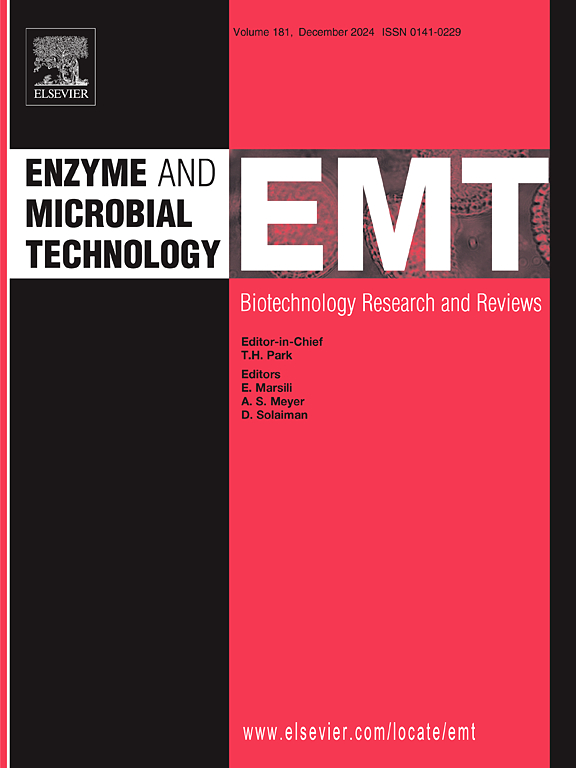食糖菌降解2-40琼脂酶的生化特性及酶活性的研究
IF 3.7
3区 生物学
Q2 BIOTECHNOLOGY & APPLIED MICROBIOLOGY
引用次数: 0
摘要
食糖降解菌2-40具有降解琼脂的活性,能有效地将琼脂降解为半乳糖。内、外琼脂酶以及新琼脂糖水解酶(NABH)在琼脂糖化生产单糖过程中起着重要作用。本研究表征了一种来自S.降解2-40的新型琼脂酶,这是一种以其特殊的多糖降解能力而闻名的海洋细菌。我们假设,这种菌株将有一个有效的和强大的琼脂酶具有理想的性质,糖化过程。分离纯化后,对该琼脂酶进行了生化分析,结果表明该酶在中等温度和较宽的pH范围内具有最佳活性。此外,Aga50D与NABH的融合使催化效率从1.873 ± 0.22 (mg/mL)−1s−1提高到4.826 ± 0.19 (mg/mL)−1s−1。与化学水解相比,使用琼脂酶的酶处理提供了一种更具选择性,环保和高产的替代方法,最大限度地减少了副产物的形成并保留了功能糖部分。该酶的主要产物是新琼脂糖(NA2),不需要任何中间体,这使其成为生产生物活性低聚糖的有吸引力的生物催化剂。这项研究强调了S.降解2-40作为工业生物技术应用的有价值的酶来源的潜力,特别是在将海洋生物质可持续转化为高价值产品方面。本文章由计算机程序翻译,如有差异,请以英文原文为准。
Elucidation of biochemical attributes and enzymatic activity of agarase from Saccharophagus degradans 2–40
Saccharophagus degradans 2–40 exhibits agarolytic activity, effectively degrading agar into galactose. Both endo- and exo-agarase, as well as neoagarobiose hydrolase (NABH), play important roles in agar saccharification for the production of monosugars. This study characterizes a novel agarase enzyme from S. degradans 2–40, a marine bacterium renowned for its exceptional polysaccharide-degrading capabilities. We hypothesized that this strain would harbor an efficient and robust agarase with desirable properties for saccharification processes. Following isolation and purification, the agarase underwent biochemical analysis, revealing optimal activity at moderate temperatures and a broad pH range. Furthermore, the fusion of Aga50D with NABH enhanced the catalytic efficiency from 1.873 ± 0.22 (mg/mL)−1s−1 to 4.826 ± 0.19 (mg/mL)−1s−1. In contrast to chemical hydrolysis, enzymatic treatment using agarase offers a more selective, eco-friendly, and high-yield alternative, minimizing by-product formation and preserving functional sugar moieties. The enzyme's ability to produce neoagarobiose (NA2) as its primary product, without any intermediates, makes it an attractive biocatalyst for the production of bioactive oligosaccharides. This study highlights the potential of S. degradans 2–40 as a valuable source of enzymes for industrial biotechnology applications, particularly in the sustainable conversion of marine biomass into high-value products.
求助全文
通过发布文献求助,成功后即可免费获取论文全文。
去求助
来源期刊

Enzyme and Microbial Technology
生物-生物工程与应用微生物
CiteScore
7.60
自引率
5.90%
发文量
142
审稿时长
38 days
期刊介绍:
Enzyme and Microbial Technology is an international, peer-reviewed journal publishing original research and reviews, of biotechnological significance and novelty, on basic and applied aspects of the science and technology of processes involving the use of enzymes, micro-organisms, animal cells and plant cells.
We especially encourage submissions on:
Biocatalysis and the use of Directed Evolution in Synthetic Biology and Biotechnology
Biotechnological Production of New Bioactive Molecules, Biomaterials, Biopharmaceuticals, and Biofuels
New Imaging Techniques and Biosensors, especially as applicable to Healthcare and Systems Biology
New Biotechnological Approaches in Genomics, Proteomics and Metabolomics
Metabolic Engineering, Biomolecular Engineering and Nanobiotechnology
Manuscripts which report isolation, purification, immobilization or utilization of organisms or enzymes which are already well-described in the literature are not suitable for publication in EMT, unless their primary purpose is to report significant new findings or approaches which are of broad biotechnological importance. Similarly, manuscripts which report optimization studies on well-established processes are inappropriate. EMT does not accept papers dealing with mathematical modeling unless they report significant, new experimental data.
 求助内容:
求助内容: 应助结果提醒方式:
应助结果提醒方式:


